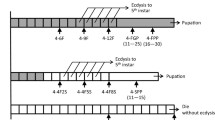Abstract
The salivary gland secretion in the dipteran Chironomus tentans is composed of approximately 15 different secretory proteins. The most well known of the corresponding genes are the four closely related Balbiani ring (BR) genes, in which the main part of each approximately 40-kb gene is composed of tandemly arranged repetitive units. Six of the seven additional secretory protein genes described share structural similarities with the BR genes and are members of the same BR multigene family. Here we report the identification of a new secretory protein gene, the spl2 gene, encoding the smallest component of the C. tentans salivary gland secretion. The gene has a corresponding mRNA length of approximately 0.7 kb and codes for a protein with a calculated molecular weight of 7,619 Da. The sp12 gene was characterized in seven Chironomus species. Based on a comparison of the orthologous gene sequences, we conclude that the sp12 gene has a repetitive structure consisting of diverged 21-by-long repeats. The repeat structure and the codon composition are similar to the so-called SR regions of the BR genes and the sp 12 gene may represent a diverged member of the BR multigene family.
Similar content being viewed by others
References
Beermann W (1952) Chromosomerenkonstanz und spezifische Modifikationen der Chromosomenstruktur in der Entwicklung und Organdifferenzierung von Chironomus tentans. Chromosoma 5:139–198
Bollag RJ, Waldman AS, Liskay RM (1989) Homologous recombination in mammalian cells. Am Rev Genet 23:199–225
Burnette WN (1981) Western blotting: electrophoretic transfer of proteins from sodium dodecyl sulfate-polyacrylamide gels to unmodified nitrocellulose and radiographic detection with antibody and radioiodinated protein A. Anal Biochem 112:195–203
Case ST, Wieslander L (1992) Secretory proteins of Chironomus tentans salivary glands: structural motifs and assembly characteristics of a novel biopolymer. In: Case ST (ed) Results and problems in cell differentiation 19. Springer-Verlag, Berlin, pp 187–236
Caskey CT, Pizzuti A, Fu Y-H, Fenwick RG JR, Nelson DL (1992) Triplet mutations in human disease. Science 256:784–789
Devereaux J, Haeberli P, Smithies O (1984) A comprehensive set of sequence analysis programs for the VAX. Nucleic Acids Res 12: 387–395
Dignam SS, Young L, Lezzi M, Case ST (1989) Identification of a developmentally regulated gene for a 140-kDa secretory protein in salivary glands of Chironomus tentans larvae. J Biol Chem 264: 9444–9452
Dignam SS, Case ST (1990) Balbiani ring 3 in Chironomus tentans encodes a 185-kDa secretory protein which is synthesized throughout the fourth larval instar. Gene 88:133–140
Dreesen TD, Bower JR, Case ST (1985) A second gene in a Balbiani ring: Chironomus salivary glands contain a 6.6 kb poly(A)+ RNA that is transcribed from a hierarchy of tandem repeated sequences in Balbiani ring 1. J Biol Chem 260:11824–11830
Edström J-E, Sierakowska H, Burvall K (1982) Dependence of Balbiani ring induction in phosphate in Chironomus salivary glands on inorganic phosphate. Dev Biol 91:131–137
Feinberg AP, Vogelstein B (1983) A technique for radiolabeling DNA restiction endonuclease fragments to high specific activity. Anal Biochem 132:6–13
Galli J, Lendahl U, Paulsson G, Ericsson C, Bergman T, Carlquist M, Wieslander L (1990) A new member of a secretory protein gene family in the dipteran Chironomus tentans has a variant repeat structure. J Mol Evol 31:40–50.
Galli J, Wieslander L (1993a) Two secretory protein genes in Chironomus tenans have arisen by gene duplication and exhibit different developmental expression patterns. J Mol Biol 237:324–334
Galli J, Wieslander L (1993b) A repetitive secretory protein gene of a novel type in Chironomus tentans is specifically expressed in the salivary glands and exhibits extensive length polymorphism. J Biol Chem 268:11888–11893
Gray IC, Jeffreys AJ (1991) Evolutionary transience of hypervariable minisatellites in man and the primates. Proc R Soc Lond [Biol]j 243:241–253
Gross-Bellard M, Oudet P, Chambon P (1973) Isolation of high molecular-weight DNA from mammalian cells. Eur J Biochem 36: 32–38
Ineichen H, Meyer B, Lezzi M (1983) Determination of the developmental stage of living fourth instar larvae of Chironomus tentans. Dev Biol 98:278–286
Laemmli UK (1970) Cleavage of structural proteins during the assembly of the head of the bacteriophage T4. Nature 27:680–685
Lyons KM, Stein JH, Smithies O (1988) Length polymorphism in human proline-rich protein genes generated by intragenic unequal crossing over. Genetics 120:267–278
Paulsson G, Lendahl U, Galli J, Ericsson C, Wieslander L (1990) The Balbiani ring 3 gene in Chironomus tentans has a diverged repetitive structure split by many introns. J Mol Biol 211:331–349
Paulsson G, Höög C, Bemholm K, Wieslander L (1992a) Balbiani ring 1 gene in Chironomus tentans: sequence organization and dynamics of a coding minisatellite. J Mol Biol 225:349–361
Paulsson G, Bernholm K, Wieslander L (1992b) Conserved and variable repeat structures in the Balbiani ring gene family in Chironomus tentans. J Mol Evol 35:205–216
Pustell J, Kafatos FC, Wobus U, Bdumlein H (1984) Balbiani ring DNA: Sequence comparisons and evolutionary history of a family of hierarchical repetitive protein encoding genes. J Mol Evol 20:281–295
Wellman SE, Case ST (1989) Disassembly and reassembly in vitro of complexes of secretory proteins from Chironomus tentans salivary glands. J Biol Chem 264:10878–10883
Wellman SE, Hamodrakas SJ, Kamitsos EI, Case ST (1992) Secondary structure of synthetic peptides derived from the repeating unit of a giant secretory protein from Chironomus tentans. Biochim Biophys Acta 1121:279–285
Wieslander L, Paulsson G (1992) Sequence organization of the Balbiani ring 2.1 gene in Chironomus tentans. Proc Natl Acad Sci USA 89:4578–4585
Wyss C (1982) Chironomus tentans epithelial cell lines sensitive to ecdysteroids, juvenile hormone, insuline and heat shock. Exp Cell Res 139:297–307
Author information
Authors and Affiliations
Additional information
Correspondence to: L. Wieslander
Rights and permissions
About this article
Cite this article
Galli, J., Wieslander, L. Structure of the smallest salivary-gland secretory protein gene in Chironomus tentans . J Mol Evol 38, 482–488 (1994). https://doi.org/10.1007/BF00178848
Received:
Revised:
Issue Date:
DOI: https://doi.org/10.1007/BF00178848




